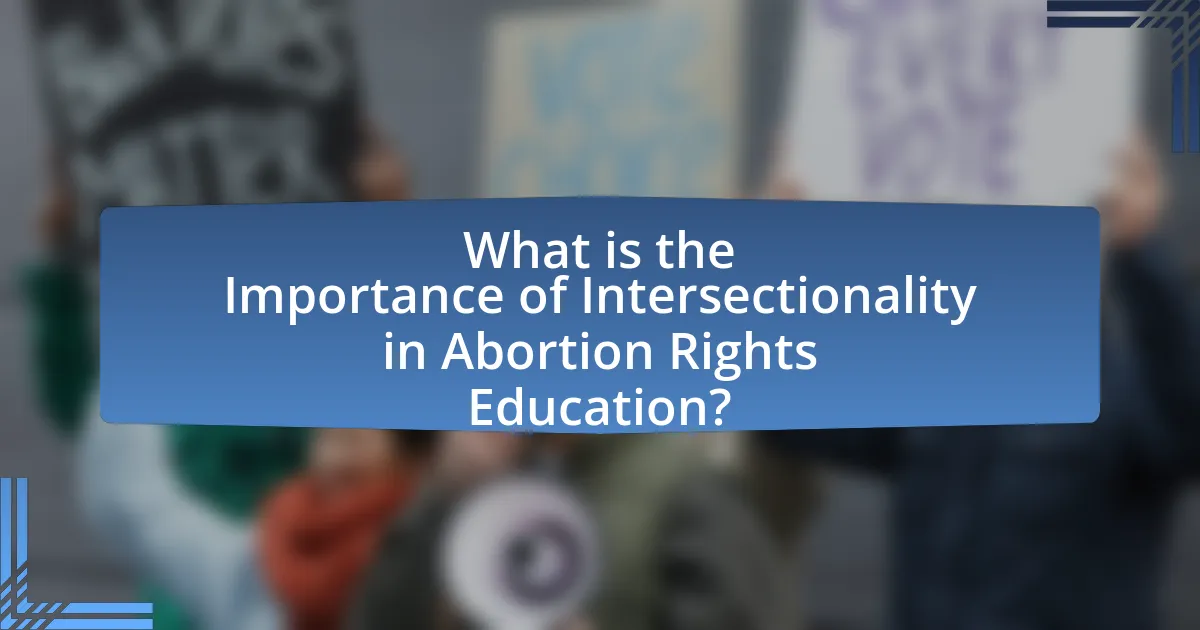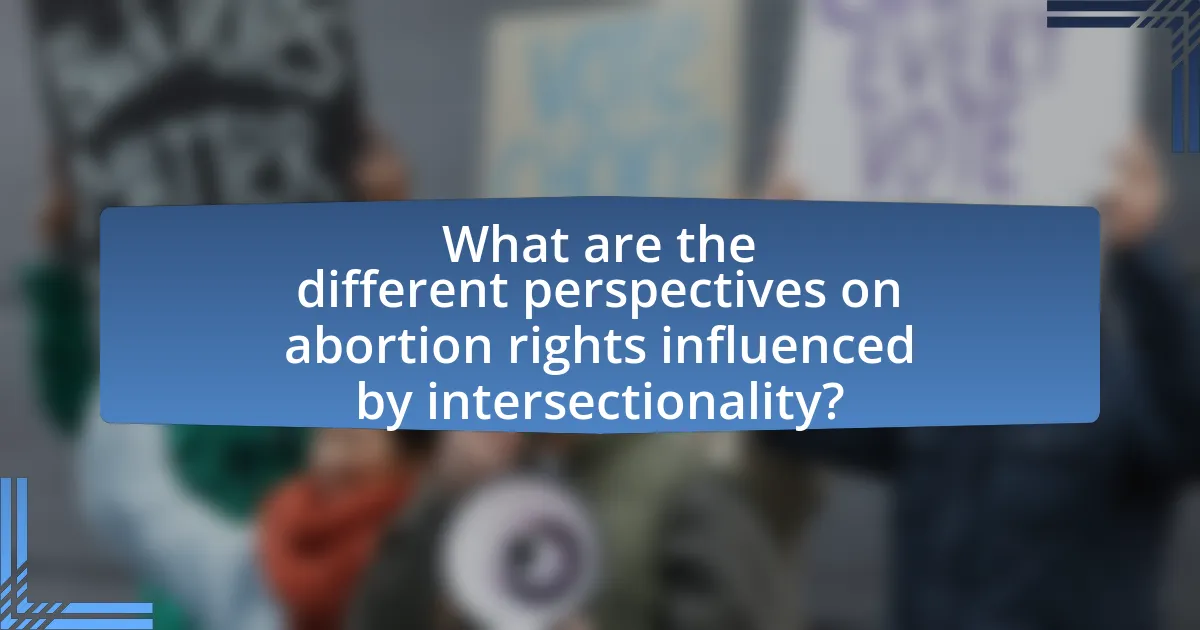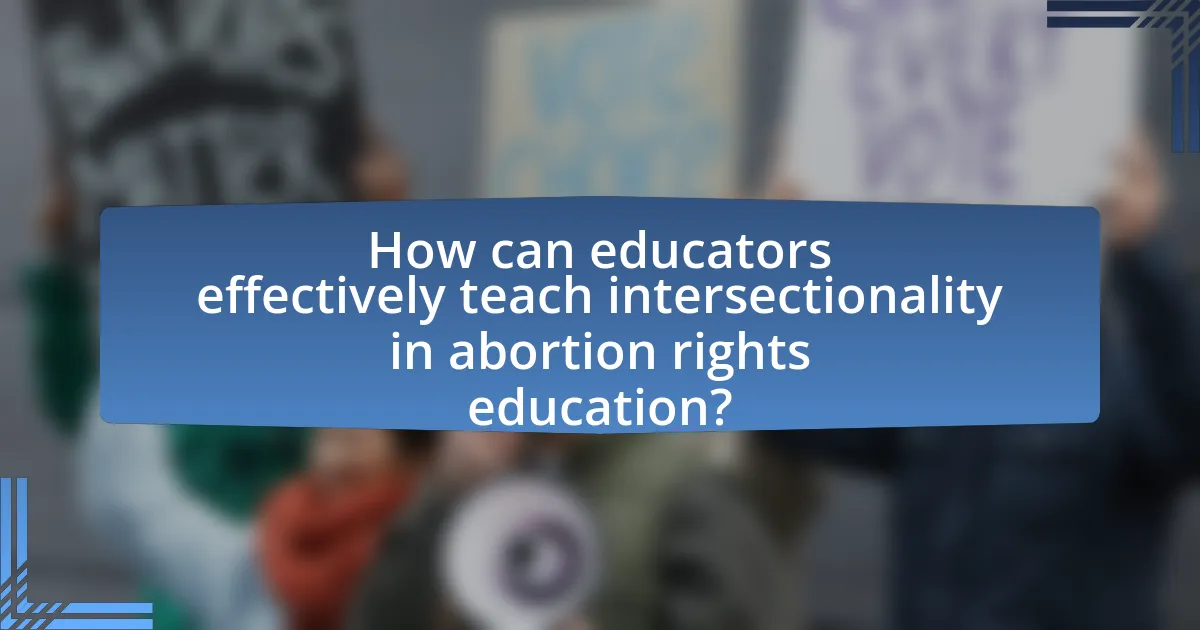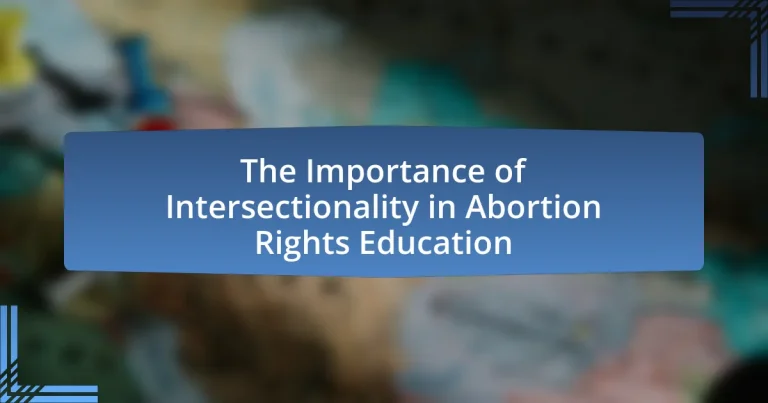The article emphasizes the significance of intersectionality in abortion rights education, highlighting how diverse identities such as race, gender, and socioeconomic status impact individuals’ access to reproductive healthcare. It discusses the unique challenges faced by marginalized groups, particularly Black and Latina women, in navigating restrictive abortion laws and systemic inequalities. Key components of intersectionality, including the need for tailored educational resources and inclusive advocacy strategies, are explored to enhance understanding and promote equitable access to abortion services. The article also outlines practical steps for educators and advocates to incorporate intersectionality into curricula and discussions, ensuring that diverse perspectives are represented in the discourse on abortion rights.

What is the Importance of Intersectionality in Abortion Rights Education?
Intersectionality is crucial in abortion rights education because it acknowledges the diverse experiences and challenges faced by individuals based on their race, gender, socioeconomic status, and other intersecting identities. This approach ensures that educational efforts address the specific barriers that marginalized groups encounter in accessing abortion services. For instance, studies show that Black and Latina women are disproportionately affected by restrictive abortion laws, highlighting the need for tailored educational resources that reflect these disparities. By incorporating intersectionality, abortion rights education can foster a more inclusive dialogue, ultimately leading to more effective advocacy and policy changes that consider the unique needs of all individuals.
How does intersectionality influence the understanding of abortion rights?
Intersectionality influences the understanding of abortion rights by highlighting how various social identities, such as race, class, gender, and sexuality, intersect to shape individuals’ experiences and access to reproductive healthcare. This framework reveals that marginalized groups often face compounded barriers to abortion access, including economic constraints, systemic racism, and lack of healthcare resources. For instance, Black and Latina women are disproportionately affected by restrictive abortion laws and have higher rates of unintended pregnancies, which underscores the need for policies that consider these intersecting factors. Research from the Guttmacher Institute indicates that low-income women are more likely to encounter obstacles in accessing abortion services, emphasizing the importance of an intersectional approach in advocating for equitable reproductive rights.
What are the key components of intersectionality in this context?
The key components of intersectionality in the context of abortion rights education include the recognition of overlapping social identities, the impact of systemic inequalities, and the necessity for inclusive advocacy. Intersectionality emphasizes how factors such as race, gender, socioeconomic status, and sexual orientation intersect to shape individuals’ experiences and access to abortion services. For instance, research by Crenshaw (1989) highlights that women of color face unique barriers to reproductive healthcare due to both racial and gender discrimination, illustrating the need for tailored educational approaches that address these complexities. This understanding is crucial for developing effective policies and educational programs that advocate for equitable access to abortion rights for all individuals, regardless of their intersecting identities.
How does intersectionality affect different demographics regarding abortion rights?
Intersectionality significantly affects different demographics regarding abortion rights by highlighting how overlapping social identities, such as race, gender, socioeconomic status, and sexual orientation, influence individuals’ access to reproductive healthcare. For instance, Black and Latina women face higher barriers to abortion services due to systemic racism and economic disparities, with studies indicating that they are more likely to experience unintended pregnancies and have less access to healthcare resources compared to their white counterparts. Additionally, LGBTQ+ individuals often encounter discrimination within healthcare systems, further complicating their access to abortion services. This intersectional lens reveals that policies and advocacy efforts must consider these diverse experiences to effectively address the unique challenges faced by various demographic groups in exercising their abortion rights.
Why is it essential to incorporate intersectionality in abortion rights education?
Incorporating intersectionality in abortion rights education is essential because it acknowledges the diverse experiences and challenges faced by individuals based on their race, class, gender identity, and other social factors. This approach ensures that the education provided addresses the specific barriers that marginalized groups encounter in accessing abortion services. For instance, studies show that Black and Latina women are disproportionately affected by restrictive abortion laws and face higher rates of maternal mortality, highlighting the need for tailored educational resources that reflect these realities. By integrating intersectionality, abortion rights education can promote a more inclusive and effective advocacy strategy that addresses systemic inequalities and empowers all individuals to make informed choices about their reproductive health.
What are the potential consequences of ignoring intersectionality?
Ignoring intersectionality can lead to significant disparities in access to abortion rights and healthcare services. When policies and educational programs do not consider the overlapping identities of individuals, such as race, gender, socioeconomic status, and sexual orientation, they fail to address the unique challenges faced by marginalized groups. For instance, research by the Guttmacher Institute indicates that women of color and low-income individuals experience higher barriers to accessing reproductive healthcare, including abortion services, due to systemic inequalities. Consequently, neglecting intersectionality perpetuates inequities, undermines the effectiveness of advocacy efforts, and ultimately harms those who are most vulnerable in society.
How can intersectionality enhance advocacy efforts for abortion rights?
Intersectionality can enhance advocacy efforts for abortion rights by addressing the diverse experiences and needs of individuals affected by reproductive policies. By recognizing how factors such as race, class, gender identity, and sexual orientation intersect, advocates can create more inclusive strategies that resonate with marginalized communities. For instance, research from the Guttmacher Institute indicates that women of color and low-income individuals face greater barriers to accessing abortion services, highlighting the necessity for tailored advocacy that considers these disparities. This approach not only broadens the coalition of support but also ensures that the voices of those most impacted by restrictive abortion laws are prioritized in the advocacy process.

What are the different perspectives on abortion rights influenced by intersectionality?
Different perspectives on abortion rights influenced by intersectionality include the recognition that race, class, gender identity, and sexual orientation significantly shape individuals’ experiences and access to reproductive healthcare. For instance, Black and Latina women often face systemic barriers that limit their access to abortion services, highlighting the intersection of race and socioeconomic status in reproductive rights discussions. Additionally, LGBTQ+ individuals may encounter unique challenges related to healthcare discrimination and stigma, which further complicates their access to abortion. Research from the Guttmacher Institute indicates that low-income women are disproportionately affected by restrictive abortion laws, emphasizing the need for an intersectional approach that considers various social identities and systemic inequalities in the fight for reproductive rights.
How do race and ethnicity shape views on abortion rights?
Race and ethnicity significantly influence views on abortion rights, as different cultural, religious, and socio-economic backgrounds shape individuals’ beliefs and attitudes. For instance, research indicates that Black and Hispanic communities often prioritize access to healthcare and reproductive rights due to historical injustices and systemic inequalities, leading to a more supportive stance on abortion rights compared to some white populations who may hold more conservative views influenced by religious beliefs. A study by the Guttmacher Institute found that 75% of Black women support abortion rights, reflecting a strong connection between race, socio-economic status, and reproductive autonomy. This intersectionality highlights the need for tailored abortion rights education that considers diverse perspectives and experiences.
What unique challenges do women of color face in accessing abortion services?
Women of color face unique challenges in accessing abortion services, including systemic racism, economic barriers, and limited healthcare access. Systemic racism manifests in discriminatory practices within healthcare systems, leading to mistrust and reduced quality of care for women of color. Economic barriers are significant, as women of color often experience higher rates of poverty, making it difficult to afford abortion services, especially in states with restrictive laws. Additionally, many women of color live in areas with fewer healthcare facilities, resulting in longer travel times and increased logistical challenges. According to the Guttmacher Institute, women of color are disproportionately affected by state-level restrictions on abortion, further complicating their access to necessary reproductive healthcare.
How do cultural beliefs impact the discourse on abortion rights among different ethnic groups?
Cultural beliefs significantly shape the discourse on abortion rights among different ethnic groups by influencing their values, norms, and attitudes towards reproductive health. For instance, in many Hispanic communities, cultural emphasis on family and religious values often leads to opposition against abortion, viewing it as morally unacceptable. Conversely, some African American communities may advocate for abortion rights as a means of addressing systemic inequalities and ensuring reproductive autonomy, reflecting a different cultural perspective on personal choice and social justice. Research indicates that these varying cultural beliefs can lead to divergent political mobilization and advocacy strategies, as seen in the 2019 Guttmacher Institute report, which highlights how cultural contexts affect access to reproductive health services across ethnic lines. Thus, cultural beliefs not only inform individual attitudes but also shape collective actions and policies regarding abortion rights within ethnic groups.
What role does socioeconomic status play in abortion rights education?
Socioeconomic status significantly influences abortion rights education by affecting access to information and resources. Individuals from lower socioeconomic backgrounds often face barriers such as limited access to healthcare, educational resources, and comprehensive sex education, which can hinder their understanding of abortion rights. Research indicates that marginalized communities, particularly those with lower income levels, are less likely to receive accurate information about reproductive health options, including abortion, due to systemic inequalities in education and healthcare access. For instance, a study published in the American Journal of Public Health found that individuals with lower socioeconomic status are more likely to experience unintended pregnancies and have less knowledge about their reproductive rights, highlighting the critical need for targeted educational initiatives that address these disparities.
How does economic inequality affect access to abortion services?
Economic inequality significantly restricts access to abortion services, particularly for low-income individuals. Research indicates that individuals with lower socioeconomic status often face financial barriers, such as the inability to afford the costs associated with abortion procedures, travel expenses to clinics, and related healthcare services. For instance, a study by the Guttmacher Institute found that nearly 75% of women who seek abortions are low-income, highlighting the disproportionate impact of economic factors on their access to reproductive healthcare. Additionally, states with restrictive abortion laws often impose waiting periods and mandatory counseling, which can further exacerbate the challenges faced by economically disadvantaged individuals, limiting their ability to obtain timely care.
What are the implications of class on the perception of abortion rights?
Class significantly influences the perception of abortion rights, as individuals from different socioeconomic backgrounds often hold varying views based on their access to resources and education. Research indicates that lower-income individuals may prioritize economic stability and access to healthcare over reproductive rights, leading to a perception that abortion is a luxury rather than a necessity. Conversely, those from higher socioeconomic classes may view abortion rights as a fundamental aspect of personal freedom and autonomy. A study by the Guttmacher Institute found that 75% of women seeking abortions cited financial constraints as a significant factor in their decision, highlighting how class shapes the discourse around abortion rights. This disparity underscores the need for an intersectional approach in abortion rights education, recognizing that class impacts not only individual choices but also societal attitudes toward reproductive health.

How can educators effectively teach intersectionality in abortion rights education?
Educators can effectively teach intersectionality in abortion rights education by integrating diverse perspectives and experiences into the curriculum. This approach involves incorporating case studies that highlight how race, class, gender, and sexuality intersect to impact individuals’ access to abortion services. For instance, research from the Guttmacher Institute indicates that marginalized communities face greater barriers to reproductive healthcare, emphasizing the need for an intersectional lens. Additionally, educators can facilitate discussions that encourage students to explore their own identities and how these influence their views on abortion rights, fostering a deeper understanding of the complexities involved. By utilizing inclusive teaching materials and promoting critical thinking, educators can create a more comprehensive and empathetic learning environment regarding abortion rights.
What strategies can be employed to incorporate intersectionality into curricula?
To incorporate intersectionality into curricula, educators can employ strategies such as integrating diverse perspectives, utilizing inclusive teaching materials, and fostering critical discussions. Integrating diverse perspectives involves including voices and experiences from various social identities, such as race, gender, and socioeconomic status, which enriches the learning experience and reflects the complexity of real-world issues. Utilizing inclusive teaching materials means selecting texts and resources that represent a range of identities and experiences, ensuring that all students see themselves reflected in the curriculum. Fostering critical discussions encourages students to engage with and analyze how intersecting identities impact individuals’ experiences, particularly in contexts like abortion rights, where factors such as race and class significantly influence access and outcomes. These strategies are supported by research indicating that inclusive curricula enhance student engagement and understanding of social justice issues.
How can case studies enhance understanding of intersectionality in abortion rights?
Case studies enhance understanding of intersectionality in abortion rights by providing real-world examples that illustrate how various social identities—such as race, class, gender, and sexuality—interact to shape individuals’ experiences and access to abortion services. For instance, a case study examining the barriers faced by low-income women of color in accessing abortion care reveals how systemic inequalities compound the challenges they encounter, such as financial constraints and lack of transportation. This specific context highlights the necessity of considering multiple dimensions of identity when discussing reproductive rights, as evidenced by research from the Guttmacher Institute, which shows that marginalized groups face disproportionately higher rates of unintended pregnancies and limited access to healthcare. By analyzing these case studies, educators and advocates can better understand the complexities of abortion rights and develop more inclusive policies that address the unique needs of diverse populations.
What resources are available for educators to teach intersectionality effectively?
Educators can access various resources to teach intersectionality effectively, including academic texts, online courses, and community workshops. Notable academic texts such as “Intersectionality” by Kimberlé Crenshaw provide foundational knowledge and frameworks for understanding the complexities of identity and social justice. Online platforms like Coursera and edX offer courses specifically focused on intersectionality, allowing educators to enhance their understanding and teaching methods. Additionally, organizations such as the Women’s Center for Creative Work and the Center for Intersectional Justice provide workshops and training sessions that equip educators with practical tools and strategies for integrating intersectionality into their curricula. These resources collectively support educators in fostering a comprehensive understanding of intersectionality in the context of abortion rights education.
What are the best practices for fostering inclusive discussions on abortion rights?
The best practices for fostering inclusive discussions on abortion rights include creating a safe space for dialogue, actively listening to diverse perspectives, and ensuring representation from marginalized communities. Establishing a safe space encourages participants to express their views without fear of judgment, which is essential for open dialogue. Actively listening to diverse perspectives allows for a deeper understanding of the complexities surrounding abortion rights, as individuals from different backgrounds may have unique experiences and insights. Ensuring representation from marginalized communities is crucial, as it highlights the intersectionality of abortion rights and acknowledges that access and experiences can vary significantly based on race, socioeconomic status, and other factors. Research indicates that inclusive discussions lead to more comprehensive understanding and advocacy, as seen in studies by the Guttmacher Institute, which emphasize the importance of considering various social determinants in reproductive health discussions.
How can facilitators create a safe space for diverse voices in discussions?
Facilitators can create a safe space for diverse voices in discussions by establishing clear ground rules that promote respect and active listening. These rules should include guidelines for speaking time, encouraging participants to share their experiences without interruption, and fostering an environment where all contributions are valued. Research indicates that structured dialogue frameworks, such as those outlined by the National Coalition for Dialogue & Deliberation, enhance inclusivity by providing participants with tools to express their perspectives while also respecting others. Additionally, facilitators should actively monitor group dynamics, addressing any instances of bias or exclusion promptly to maintain a supportive atmosphere.
What techniques can be used to encourage critical thinking about intersectionality in abortion rights?
Techniques to encourage critical thinking about intersectionality in abortion rights include facilitating discussions that incorporate diverse perspectives, using case studies that highlight the experiences of marginalized groups, and implementing reflective writing exercises. Facilitating discussions allows participants to engage with various viewpoints, fostering an understanding of how race, class, gender, and sexuality intersect in the context of abortion rights. Case studies, such as those examining the impact of restrictive abortion laws on low-income women of color, provide concrete examples that illustrate the complexities of intersectionality. Reflective writing exercises encourage individuals to analyze their own biases and assumptions, promoting deeper engagement with the topic. These methods collectively enhance critical thinking by challenging participants to consider the multifaceted nature of abortion rights and the diverse experiences that shape them.
What practical steps can individuals take to advocate for intersectional approaches in abortion rights education?
Individuals can advocate for intersectional approaches in abortion rights education by actively engaging in community outreach and education initiatives that highlight the diverse experiences of marginalized groups. This can include organizing workshops that focus on the unique challenges faced by women of color, LGBTQ+ individuals, and low-income communities regarding reproductive rights. Research indicates that intersectional education increases awareness and understanding of how various social identities intersect to impact access to abortion services. For example, a study by Crenshaw (1989) emphasizes the necessity of considering multiple identities in social justice movements, which supports the need for tailored educational programs. Additionally, individuals can collaborate with local organizations that specialize in reproductive justice to amplify marginalized voices and ensure that their specific needs and perspectives are included in the conversation.


